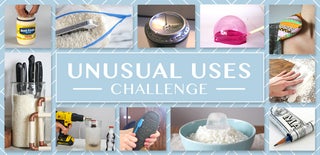Introduction: Laser Microscope & Laser Diffraction
LASER stands for Light Amplification by Stimulated Emission of Radiation. As the name itself says it's a powerful beam of light which is coherent and monochromatic. Let's see how we can make a microscope with this key-chain LASER.
Let's make 2 things.
1.Laser Microscope
2.Laser Diffraction
PLEASE DON'T FORGET TO VOTE ME IN CONTESTS. THANKS FOR YOUR PRECIOUS TIME.
Step 1: Parts Required
1. Key-chain LASER (You can use any LASER source such as laser diode .etc)
2. Injection Syringe(Be careful with the needle).
3.Cellophane Tape
4.Thin Copper Wire(Extracted from old electronic clock)
5.Stands for holding the things
6.White Chart paper for Screen
7.Clip for holding the button of key-chain laser
Step 2: 1. Laser Microscope
Take the syringe and fill it with pond water (To see aquatic creatures in micro level) then place it on a stand or on top of a box.
Wrap the chart paper around a cardboard to make a screen.
Place the screen about 1 meter from the syringe arrangement.
With the help of clip hold the button of key-chain laser in ON position.
Secure the laser setup with the help of a stand or a box.
Place this setup 2 feet away from the syringe arrangement.
Step 3: Setting Up...!
Now we have arranged everything let's put the things into action.
Gently press the syringe piston such a way that water droplet should come at the end of needle. This is the main part of our microscope i.e Convex lens. Yes, water droplet acts as a convex lens.
Focus the laser beam such that it should point the water droplet. Due to refraction from the water lens it projects the laser light directly on screen. This will form a red patch on the screen.
Step 4: The Final Show: Microbes.
Turn off the light and see the nice view of the microbes. You can use this experimental setup to check the purity of drinking water, boiled water etc.
Now you can observe microbes, bacteria etc. roaming around the tiny droplet of water.
You need patience to watch this, of course in order to see wonders of science you need patience. :)
Step 5: 2. Laser Diffraction
We observe science phenomena happening in our day to day life (If we think in scientific way) like reflection, refraction, interference, lateral shift and normal shift etc. But what about diffraction ... This is quite rare we observe (It also happens in regular way but we don't notice it). Because for diffraction to happen the size of the obstacle or edge must be comparable with the wavelength of light i.e 400nm to 750nm . So the obstacles must be in terms of micrometers.
The definition of diffraction is as follows:
Diffraction is the slight bending of light as it passes around the edge of an object. The amount of bending depends on the relative size of the wavelength of light to the size of the opening. If the opening is much larger than the light's wavelength, the bending will be almost unnoticeable.
Source: Google
So let's do it
Step 6: Arranging the Things
The thickness of copper wire which I got from an old electronic clock is around 5 to 10 micro meter. This will be good for our experiment. My key-chain laser has a wavelength of around 650nm or 0.65 micro meter. Diffraction can happen if the laser passes through this obstacle.
Wrap a thin copper wire around a tape and fasten it with some extra tape.
Place it on the stand or a box at a height as shown in images.
Place the laser set up as earlier (2 feet from wire setup)
Step 7: The LASER Show
Focus the laser beam in such a way that it should be cut by the thin wire. This leads to the diffraction pattern on the screen as described earlier.The fringes of the diffraction pattern are clearly visible as shown here.
PLEASE DON'T FORGET TO VOTE ME IN CONTESTS. THANKS FOR YOUR TIME.

Participated in the
Explore Science Contest 2017

Participated in the
Invention Challenge 2017

Participated in the
Unusual Uses Challenge 2017













